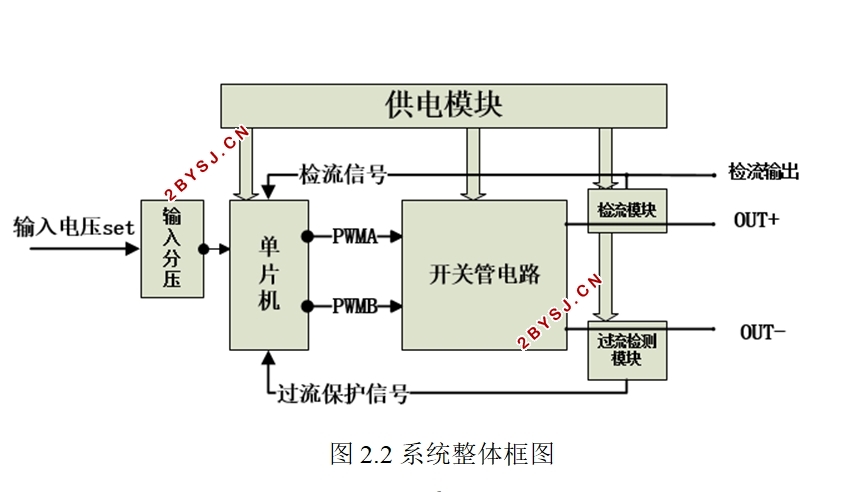基于STM32F030的数字化电流源设计
无需注册登录,支付后按照提示操作即可获取该资料.
基于STM32F030的数字化电流源设计(任务书,开题报告,外文翻译,论文12000字,答辩记录,答辩PPT)
摘要
作为直流电源的分支,直流电流源一直被广泛的应用于科学研究、测试计量部门、航空航天和汽车电子等领域。本文研究内容是基于汽车减震的需要,设计了一款对输入控制信号反应迅速的数字化电流源。
本文首先大概的说明了电流源的研究现状和今后的发展趋势,然后介绍了电流源的理论基础和总体设计思路,之后用较大篇幅章节详细阐述了数字化电流源的硬件、软件设计方案及过程。其中采用DC/DC变换器中的同步Buck组成全桥电路作为开关电路,驱动方式选择双路PWM。有检流模块进行反馈形成闭环,有过流检测反馈形成保护。并设计了供电电路,在输入仅有24V直流电压时,实现对所有模块的供电。软件设计中使用增量式PID算法进行闭环控制,并设计算法解决了PID算法中积分饱和缺陷,防止电路出现积分饱和后需要长时间回复,提高电路的速度与精度。
最后测试电流源的性能,做出总结并给出改进建议。
关键字:同步Buck;电流源;PID;STM32
Abstract
As a branch of DC power supply, DC current source has been widely used in scientific research, metrology and testing departments, aerospace and automotive electronics and other fields. The research content of this paper is based on the need of automobile shock absorption, and a digital current source which responds rapidly to the input control signal is designed.
In this paper, the current research status and development trend of current source are described. Then the overall design and theoretical basis of the current source are introduced. Then the hardware and software design scheme and process of the current source are described in detail. The synchronous Buck in the DC/DC converter is used as the full bridge circuit as the switch circuit and the driving mode selects the dual PWM. There are check modules to form feedback loops, and overcurrent detection feedback forms protection. And a power supply circuit is designed to supply all the modules when only 24V DC voltage is input. In the software design, the incremental PID algorithm is used for closed loop control. The design algorithm solves the integral saturation defect in the PID algorithm and prevents the circuit from taking a long time recovery after integration saturation to improve the speed and precision of the circuit.
Finally, the performance of the current source is tested and summarized, and suggestions for improvement are given
Key Words: Synchronous buck;Current source;PID;STM32


目录
第1章绪论 1
1.1 研究背景及意义 1
1.2 发展趋势和研究现状 1
1.2.1 电流源的研究现状 1
1.2.2 电流源发展趋势 2
1.3 课题研究目标和内容 3
1.3.1 课题研究目标 3
1.3.2 课题研究内容 3
1.4 本文的结构和安排 4
第2章数字电流源总体方案设计 5
2.1 电流源总体概述 5
2.1.1 设计功能要求 5
2.1.2 数字电流源外部接口 6
2.1.3 电流源整体框图 6
2.2 数字电流源各模块功能分析 7
第3章数字化电流源各模块硬件设计 8
3.1 恒流源模块硬件设计 8
3.1.1 方案选择 8
3.1.2 恒流源硬件电路 15
3.2 电流源辅助电路设计 19
3.2.1 输入分压 19
3.2.2 单片机电路 20
3.2.3 供电电路 20
第4章数字电流源软件程序设计 23
4.1 软件结构设计 23
4.1.1 软件结构框图 23
4.1.2 软件流程图 23
4.2 ADC和PWM程序设计与实现 25
4.2.1 ADC和PWM参数配置 25
4.2.2 ADC数字滤波算法程序 25
4.2.3 设定电流值与反馈电流值的计算 26
4.3 PID算法 27
4.3.1 PID原理 27
4.3.2 PID算法离散化 28
4.3.3 PID算法实现 29
第5章数字化电流源测试 31
5.1 直流输入测试 31
5.2 交流输入测试 32
第6章总结与展望 35
6.1 总结 35
6.2 展望 35
参考文献 36
致谢 37
